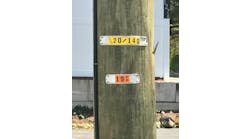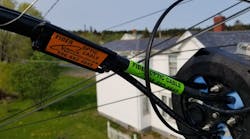Latest from Safety
Expectation Shifts to Lifetime Readability
Whether at substations or in the field, electric utility transmission and distribution identification products such as safety signs, tags, and markers are critical to safe, efficient operation, maintenance, and repair. These brief warnings or instructions, comprised of letters, numbers, and symbols, must effectively convey key information to personnel. This is crucial not only to identify the location and type of equipment but also to protect utilities from the risk of personnel injury and litigation.
Unfortunately, traditional painted and laminated identification products frequently fade or delaminate when continually exposed to outdoor weather or punishing conditions. Solar UV, rain, snow, ice, and windblown debris as well as humidity and seasonal temperature fluctuations inevitably degrade these identification products in a matter of years.
Over time, outdoor exposure can cause painted and laminated numbers and symbols to peel or fade. Even supposedly durable products designed for this purpose can become unreadable over ten years or more. Consequently, when safety warnings, asset location, or identifiers are needed most, technicians may make mistakes or waste time.
Given what is at stake, utilities are now increasingly shifting away from identification products that are marketed as long-lasting and durable but that have the potential to fade or peel, to those designed to withstand decades of abuse without becoming unreadable.
The Importance of Safety Signage
In the electrical utility industry, identification products are utilized just about everywhere.
In substations, signs often warn of arc flash and shock hazard, which OSHA states can result in “serious injury and even death.” Markers and tags typically specify when Lock Out Tag Out (LOTO) is necessary before the set-up, maintenance, service, or repair of energized equipment. Substation structure numbers are also necessary for rapid identification and servicing.
On large, high-voltage transmission towers crossing and direction signs signal trouble areas. Phase tags are also commonly used to indicate phase polarity on the towers, which is important because connecting the wrong phases can lead to dangerous explosions, serious injury, and extended downtime. Transmission towers also utilize aerial observation pole tags for rapid identification and better visibility to aircraft.
Smaller, lower-voltage distribution lines deliver power to homes and businesses on smaller poles. Pole identification products, such as tags and markers, are used to track and identify assets, data, and other vital information. Pole tags can also be used to identify the pole’s owner, maintenance history, and other valuable data.
Transformers, whether in the substation or on poles also indicate phase with tags. Similarly, markers and signage are used to indicate LOTO situations.
Not Good Enough
Too many in the industry believe that their current identification products are “good enough” even as legibility becomes compromised over the years. However, the paint will fade and the laminate will peel on these products usually within five to ten years, requiring replacement.
Yet inspecting and replacing illegible products seldom – if ever – occurs on a comprehensive and timely basis because it can be a time consuming, laborious process that is shortchanged in deference to higher priorities. Neglecting to do so, however, can lead to dangerous safety lapses as well as inefficient operation.
Designed for Lasting Safety
So, how can safety signage be designed and constructed to ensure readability after decades? The answer requires a shift in thinking. For applications with the longest lasting
requirements, impermanent paints and laminates should be avoided in favor of much more durable solutions. The signage should also be constructed using robust substrate or embossed characters that can take a beating from Mother Nature.
As an example, one type of sturdy signage system developed for the industry, called EVERLAST by Tech Products, Inc., a leader in the manufacture of industrial identification products for 75 years, is made of thick, high impact polyolefin plastic with copy and pictograms that are permanently embedded through the entire thickness of the substrate.
Tech Products, Inc., which serves electric and gas utilities, telecom and cable companies, oil and gas pipelines, and OEMs, offers five legacy brands and approximately 10,000 diverse products for these industries.
The polyolefin plastic is impervious to sun, wind, rain, humidity, salt water, and temperature variations as well as fumes and acid or alkali solutions. The characters can be seen from a distance and have sharp contrast. The signage can be cut, scratched, even shot through with little or no effect to the embedded characters, which helps to ensure readability decades later.
Third-party certification validates the durability of this approach. UL performed numerous durability tests on the signs in compliance with UL and ASTM standards. When the signs were subjected to the equivalent of 43 years of UV exposure, salt spray, vibration, abrasion, and temperature variation, the test results showed no change in color or legibility.
Another effective method of creating permanent signage is to utilize embossing.
Embossing creates raised characters in metal materials to improve legibility even when covered in dust, dirt, or even paint.
When lasting transmission and distribution markers are required, for example, deep embossed pole badge, pole inspection, and pole markers can be constructed of unpainted, embossed aluminum, brass, or stainless steel. The highly defined characters remain legible for the life of the pole.
Alternatively, on metal reflective pole tags, black characters can be screen printed on construction-grade yellow or sliver reflective sheeting so that it is durable, and UV stabilized. These tags can be used anywhere in areas that need to be seen with a flashlight.
For tight, confined spaces where close up reading is required, miniature markers with raised, 3D characters, called FastTags by Tech Products, Inc., can also be designed to remain legible even in low light, oily, or dusty environments. The raised, 3D characters are hot stamped with high quality UV stable foil and are nonconductive and non-corroding, which is ideal for environments exposed to water such as utilities, offshore rigs, and sewer systems.
No replacing physical signage
Another reason these identification products need to last decades is they are sure to remain as valuable tools for utilities even as new technologies for asset management and maintenance are employed throughout the industry. Even with state-of-the-art technology like geographic information systems (GIS) and global positioning systems (GPS), electrical utilities will continue to require traditional physical identification products such as pole markers, for example.
Although pole tags are not mandated by regulations, many utilities choose to use them to assist with recovery efforts after a regional outage by still posting serialized GIS or GPS pole marking and numbering correspond to a pole’s geographic location using GIS/GPS coordinates. During emergencies like hurricanes, mutual aid situations often arise where utility trucks from different regions are called on for assistance. These trucks may not have access to GIS or GPS location information, making pole tags essential for proper identification and location guidance.
Although electric utilities have long utilized identification products in the field or in substations, the potential that critical information could become obscured or unreadable in a matter of years is no longer acceptable as a standard. Even when not strictly mandated, utilities that opt to use innovative products designed to last for many decades can significantly improve safety and uptime, while reducing potential liability and litigation risk.
For more information, call 1-800-221-1311; email [email protected]; or visit www.techproducts.com.
###




